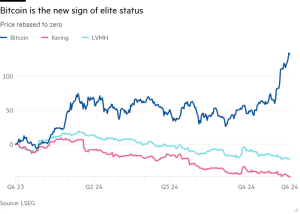IMF surcharges saga could threaten its credibility
Unlock the Editor’s Digest for free
Roula Khalaf, Editor of the FT, selects her favourite stories in this weekly newsletter.
The writer is a professor at Columbia University and a Nobel laureate in economics
Ukraine, besieged by war, pays the IMF hundreds of millions of dollars a year in extra borrowing surcharges in addition to its regular debt payments. The IMF levies those surcharges on countries whose debts with the fund exceed certain thresholds.
Twenty-two countries now pay surcharges — and the count keeps growing. This includes countries riddled by conflicts or natural disasters for which they are not responsible. These nations, all suffering deep debt crises, are projected to pay the IMF roughly $2bn collectively in surcharges alone every year for the next five years. Note that these debt crises are development crises, with enormous suffering among those in the afflicted countries. The money taken away from places where poverty is increasing goes to finance the IMF’s basic operations — from which all countries benefit, including the richest.
This should be unacceptable. US legislators, presidents such as Brazil’s Luiz Inácio Lula da Silva, the G20 and many civil society organisations from around the world have called for the IMF to reform its lending policy to reduce borrower countries’ repayment burdens. The IMF was founded to be a steward of international financial stability, but its interest rate policy does exactly the opposite. Surcharges lead to further debts, and they don’t speed up repayment.
The IMF surcharge policy also exacerbates borrowing countries’ debts in another way. Countries must pay back the IMF before other creditors, so heavily indebted countries use up their foreign currency reserves to repay the fund. That limits their access to international capital markets, which then keeps them more dependent on the IMF.
The IMF finally seems poised to reform its surcharge policy over the next few days. But there is good reason to fear that the reforms its board is considering are insufficient.
We don’t know the details of its proposals. And when journalists and NGO leaders have asked the IMF for specifics, it has declined to comment. This lack of transparency is preventing economic experts from analysing the proposals and civil society representatives from advocating for the interests of the taxpayers who will ultimately be saddled with the bills and for the wellbeing of the citizens in the afflicted countries.
Media reports suggest that there are three elements to the proposed reform that will be submitted to a vote.
One would focus on the margin that all borrowing countries pay. According to IMF rules, the margin should be set to cover intermediation expenses and to create net income for placement to reserves. Leaving aside the question of whether the IMF should build reserves, our computations suggest that in the current circumstances the value of the margin that would meet the rule is 15 basis points rather than the 100 that the IMF charges over all its lending. The fund should be transparent about how it computes the margin that meets its rules.
Another element that will almost certainly be on the table is the time-based surcharges, which kick in when a country has excess indebtedness for more than a certain period. If the surcharges are not completely eliminated, at the very least the IMF should extend the threshold for the activation of time-based surcharges, as it is external shocks like the pandemic, conflict and extreme climate events that often make it difficult, if not impossible, for countries to repay.
The third and final element seems to be an increase of the threshold over which so-called level-based surcharges are paid. It has been reported that the proposal is to raise thresholds so that surcharges would kick in after a country’s debt exceeds 300 per cent of its IMF quota, rather than the current 187.5 per cent.
This is the most alarming of all the elements proposed, as this rule is not even consistent with the threshold that the IMF itself defines as “exceptional lending”. Currently, the IMF defines the “normal limit” for cumulative access to its resources at the value of 600 per cent of its quota. If that is the case, why would level-based surcharges be applied to lending below that threshold? There is an incoherence here that only seems to reflect the fund’s appetite for building reserves, even if it means depriving hundreds of millions of people of critical public services that are fundamental to their human development.
If the IMF plans to pass off an incremental gesture as meaningful reform, it will put its credibility at risk. Eliminating surcharges won’t change the world. But the fund does at least have a clear opportunity on this issue to show that it is ready to look reality in the face, do what its founding mandate demands and ensure international financial stability.
#IMF #surcharges #saga #threaten #credibility




